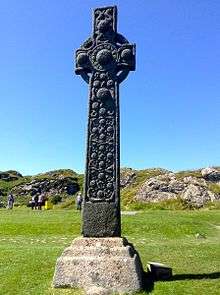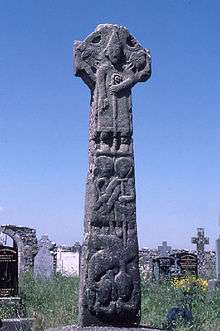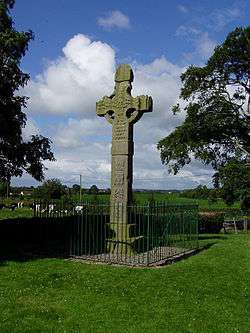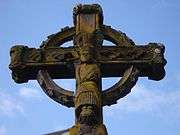Ringed cross

The ringed cross is a class of Christian cross symbols featuring a ring or nimbus. The concept exists in many variants and dates to early in the history of Christianity. One variant, the cruciform halo, is a special type of halo placed behind the head of Jesus in Christian art. Other common variants include the Celtic cross, used in the stone high crosses of Ireland and Britain; some forms of the Coptic cross; and ringed crosses from western France and Galicia.
History
The nimbus or ringed shape was appended to the Christian cross and other symbols relatively early. In these contexts it apparently derived from the earlier Roman garland of victory. The Chi Rho-in-circle motif was widespread in the Roman Empire by the late 4th century, and garlanded and ringed crosses were popular in imperial Ravenna by the 5th century, influencing the later versions.[1] The cruciform halo or cross halo, a halo incorporating a cross, emerged as a distinctive type of halo painted behind the head of members of the Holy Trinity, especially Jesus, and occasionally others.[2] In other cases, the combination of cross and nimbus symbolized the presence of Christ throughout the cosmos, with the nimbus representing the celestial sphere. Notable early examples include the cosmological ringed cross in the 5th-century Mausoleum of Galla Placidia, and the 6th-century Crux Gemmata in the Basilica of Sant'Apollinare in Classe.[3]
Examples
Celtic cross
The Celtic cross is a variant of the ringed cross that emerged in Ireland and Britain in the Early Middle Ages. It is a Latin cross featuring a nimbus surrounding the intersection of the stem and arms. The Celtic cross became widespread through the distinctive stone high crosses erected across the islands beginning in the early 8th century; most (but not all) of these monuments take the form of the Celtic cross. Scholars debate the origins of the type, but it is related to earlier types of ringed crosses such as the "cosmological cross" used in Ravenna.[3] St. John's Cross at Iona, an Irish monastery off the coast of Scotland and a major pilgrimage center, may be the prototype for all high crosses.[4] Most high crosses were made between the 8th and 10th centuries, with a briefer revival occurring in Ireland in the late 11th and 12th centuries.[5]
The Celtic cross saw a resurgence in the mid-19th century, following new studies and reconstructions of the medieval high crosses. They subsequently became common objects in art, architecture, and merchandise during the Celtic Revival. They have since remained popular symbols of Ireland and "Celtic" identity.[6]
-

St. Martin's Cross, Iona, Scotland
-
_(photo).jpg)
Muiredach's High Cross, Monasterboice, Ireland
-

Doorty's Cross, Kilfenora, Ireland
-

Ardboe High Cross, Ardboe, Northern Ireland
-

Gosforth Cross, Gosforth, England
Continental Europe
France
A type of ringed cross, called the croix nimbée ("cross with nimbus") is found in France. Their design is different from the Celtic cross, but all the French examples are quite analogous in shape to each other. They are found mainly in the western part of France: in Normandy, Brittany, and Limousin as far as Auvergne in the centre. Most of them were made around the 15th century. One can be seen on the spire of Orléans Cathedral, in the Loire valley.
In Lower Normandy, in Cotentin, many churches have kept their tombstones decorated with a cross.[7][8]
-
Normandy, Veules-les-Roses Cross
-

Normandy, Saint-Pierre-en-Port Cross
-

Brittany, Sant-Kadoù Island, Stêr an Intel (Étel river)
-

Auvergne, details of a high cross at Chambon-sur-Lac
-

Normandy, Tombstones in the St Germain church, Flamanville
Galicia
A distinct form of ringed cross similar to Celtic variant is found in Galicia in Spain, often topping horreos (granaries) as a protective measure against any kind of evil.[9] They can also be found atop churches and, since the beginning of the 20th century, in cemeteries, but they are unusual in cruceiros (high crosses). There is a very characteristic Galician Medieval style[10] that combines a Celtic cross with a Celtic simple knot; it is similar to the St Maur cross at Glanfeuil Abbey.[11][12]
-

Modern copy of the Romanesque Agnus Dei topping the church of Saint Mary Salome, in Santiago de Compostela
-
Gothic cross atop the church of Saint Susanna, in Santiago de Compostela
-

A Latin cross and a high cross atop a Galician hórreo (granary)
-

high crosses topping the sanctuary of a Virxe da Barca ('Our Lady of the Boat'), Muxía
-

Cross topping the church of Saint Lazarus, Santiago de Compostela
References
- ↑ Herren, Michael W.; Brown, Shirley Ann (2002). Christ in Celtic Christianity: Britain and Ireland from the Fifth to the Tenth Century. Boydell Press. pp. 192–193. ISBN 0851158897.
- ↑ Sill, Gertrude Grace (2011). A Handbook of Symbols in Christian Art. Simon & Schuster. pp. 59–60. ISBN 1439123845.
- 1 2 Herren, Michael W.; Brown, Shirley Ann (2002). Christ in Celtic Christianity: Britain and Ireland from the Fifth to the Tenth Century. Boydell Press. pp. 199–200. ISBN 0851158897.
- ↑ Werner, Martin (1990). "On the Origins of the Form of the Irish High Cross". Gresta. Gesta, Vol. 29, No. 1. 29 (1): 98–110. JSTOR 767104.
- ↑ Cronin, Rhoda (1998). "Late High Crosses in Munster: Tradition and Novelty in Twelfth-Century Irish Art". In Monk, Michael A.; John, Sheehan. Early Medieval Munster: Archaeology, History and Society. Cork University Press. pp. 138–146. ISBN 1859181074. Retrieved October 26, 2016.
- ↑ William, Maggie McEnchroe (2001). "Constructing the Market Cross at Tuam: The Role of Cultural Patriotism in the Study of High Crosses". In Hourihane, Colum. From Ireland Coming: Irish Art from the Early Christian to the Late Gothic Period and Its European Context. Princeton University Press. pp. 141–160. ISBN 069108825X. Retrieved October 25, 2016.
- ↑ Frédéric Scuvée, Les croix nimbées du Cotentin in Heimdal n°2, 1971.
- ↑ Stéphane Laîné, Baligan ou les avatars d'un émir », in Remembrances et Resveries, Recueil d'articles en hommage à Jean Batany rassemblés et édités par Huguette Legros, Denis Hüe et Joël Grisward, Orléans, Éditions Paradigme.
- ↑ Mariño Ferro, Xosé Ramón (2010). Dicionario de etnografia e antropoloxía de Galiza (1 ed.). Vigo: Nigra Trea. p. 212. ISBN 978-84-95364-84-5.
- ↑ "There are many types of (church roof) crosses, but the interlaced ones are the most characteristic and the most flamboyant of all those to be found throughout the country (Galicia). They are made up, in most cases, by a Christian cross of equal arms, not unlike a Pate or Greek cross, with a circle that surrounds it; along with this, the cross is ornamented with interlaces in the way of the purest early Celtic art" ("Hai cruces antefixas de moitos tipos pero son as entrelazadas as máis chamativas e características de todas as que podemos atopar polo país. Están formadas na maior parte dos casos por unha cruz cristiá xeralmente de brazos iguais, do tipo da cruz de paté ou grega, e un circulo que a rodea; xunto con isto está ornamentada cun entrelazado da máis pura arte celta primitiva") Romero, Bieito (2009). Xeometrías máxicas de Galicia. Vigo: Ir Indo. pp. 122–176. ISBN 978-84-7680-639-5.
- ↑ The meaning of the St Maur cross (French)
- ↑